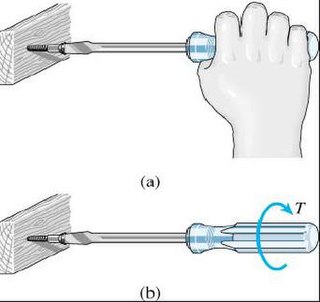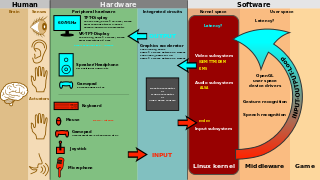Related Research Articles
Usability engineering is a professional discipline that focuses on improving the usability of interactive systems. It draws on theories from computer science and psychology to define problems that occur during the use of such a system. Usability Engineering involves the testing of designs at various stages of the development process, with users or with usability experts. The history of usability engineering in this context dates back to the 1980s. In 1988, authors John Whiteside and John Bennett—of Digital Equipment Corporation and IBM, respectively—published material on the subject, isolating the early setting of goals, iterative evaluation, and prototyping as key activities. The usability expert Jakob Nielsen is a leader in the field of usability engineering. In his 1993 book Usability Engineering, Nielsen describes methods to use throughout a product development process—so designers can ensure they take into account the most important barriers to learnability, efficiency, memorability, error-free use, and subjective satisfaction before implementing the product. Nielsen’s work describes how to perform usability tests and how to use usability heuristics in the usability engineering lifecycle. Ensuring good usability via this process prevents problems in product adoption after release. Rather than focusing on finding solutions for usability problems—which is the focus of a UX or interaction designer—a usability engineer mainly concentrates on the research phase. In this sense, it is not strictly a design role, and many usability engineers have a background in computer science because of this. Despite this point, its connection to the design trade is absolutely crucial, not least as it delivers the framework by which designers can work so as to be sure that their products will connect properly with their target usership.

Usability can be described as the capacity of a system to provide a condition for its users to perform the tasks safely, effectively, and efficiently while enjoying the experience. In software engineering, usability is the degree to which a software can be used by specified consumers to achieve quantified objectives with effectiveness, efficiency, and satisfaction in a quantified context of use.
ISO 9241 is a multi-part standard from the International Organization for Standardization (ISO) covering ergonomics of human-computer interaction. It is managed by the ISO Technical Committee 159. It was originally titled Ergonomic requirements for office work with visual display terminals (VDTs). From 2006 onwards, the standards were retitled to the more generic Ergonomics of Human System Interaction.
User experience (UX) is how a user interacts with and experiences a product, system or service. It includes a person's perceptions of utility, ease of use, and efficiency. Improving user experience is important to most companies, designers, and creators when creating and refining products because negative user experience can diminish the use of the product and, therefore, any desired positive impacts. Conversely, designing toward profitability as a main objective often conflicts with ethical user experience objectives and even causes harm. User experience is subjective. However, the attributes that make up the user experience are objective.
Kansei engineering aims at the development or improvement of products and services by translating the customer's psychological feelings and needs into the domain of product design. It was founded by Mitsuo Nagamachi, Professor Emeritus of Hiroshima University. Kansei engineering parametrically links the customer's emotional responses to the properties and characteristics of a product or service. In consequence, products can be designed to bring forward the intended feeling.

User interface (UI) design or user interface engineering is the design of user interfaces for machines and software, such as computers, home appliances, mobile devices, and other electronic devices, with the focus on maximizing usability and the user experience. In computer or software design, user interface (UI) design primarily focuses on information architecture. It is the process of building interfaces that clearly communicate to the user what's important. UI design refers to graphical user interfaces and other forms of interface design. The goal of user interface design is to make the user's interaction as simple and efficient as possible, in terms of accomplishing user goals.
Cognitive ergonomics is a scientific discipline that studies, evaluates, and designs tasks, jobs, products, environments and systems and how they interact with humans and their cognitive abilities. It is defined by the International Ergonomics Association as "concerned with mental processes, such as perception, memory, reasoning, and motor response, as they affect interactions among humans and other elements of a system. Cognitive ergonomics is responsible for how work is done in the mind, meaning, the quality of work is dependent on the persons understanding of situations. Situations could include the goals, means, and constraints of work. The relevant topics include mental workload, decision-making, skilled performance, human-computer interaction, human reliability, work stress and training as these may relate to human-system design." Cognitive ergonomics studies cognition in work and operational settings, in order to optimize human well-being and system performance. It is a subset of the larger field of human factors and ergonomics.
Engineering psychology, also known as Human Factors Engineering, is the science of human behavior and capability, applied to the design and operation of systems and technology. As an applied field of psychology and an interdisciplinary part of ergonomics, it aims to improve the relationships between people and machines by redesigning equipment, interactions, or the environment in which they take place. The work of an engineering psychologist is often described as making the relationship more "user-friendly."
Capability management is a high-level management function, with particular application in the context of defense.
Systems psychology is a branch of both theoretical psychology and applied psychology that studies human behaviour and experience as complex systems. It is inspired by systems theory and systems thinking, and based on the theoretical work of Roger Barker, Gregory Bateson, Humberto Maturana and others. Groups and individuals are considered as systems in homeostasis. Alternative terms here are "systemic psychology", "systems behavior", and "systems-based psychology".
Human-centered design is an approach to problem-solving commonly used in process, product, service and system design, management, and engineering frameworks that develops solutions to problems by involving the human perspective in all steps of the problem-solving process. Human involvement typically takes place in initially observing the problem within context, brainstorming, conceptualizing, developing of concepts and implementing the solution.
Human-centered design is an approach to interactive systems development that aims to make systems usable and useful by focusing on the users, their needs and requirements, and by applying human factors/ergonomics, and usability knowledge and techniques. This approach enhances effectiveness and efficiency, improves human well-being, user satisfaction, accessibility and sustainability; and counteracts possible adverse effects of use on human health, safety and performance.

Industrial engineering is an engineering profession that is concerned with the optimization of complex processes, systems, or organizations by developing, improving and implementing integumentary systems of people, money, knowledge, information and equipment. Industrial engineering is central to manufacturing operations.
Anthony D. Andre is a researcher, practitioner, and academic in the fields of human factors, ergonomics, usability and product design. He is the founding principal of Interface Analysis Associates, an international human factors and ergonomics consultancy. Andre pioneered the behavioral approach to ergonomics which included behavior modification and computer skill development as its basis, in direct opposition to common product-based approaches. He is a founding member and adjunct professor of the HF/E Graduate Program at San Jose State University. He founded the International Conference on Human Factors and Ergonomics in Health Care, co-created the Ergo-X conference, managed the ergonomic content for several of the annual California Association of Rehabilitation and Re-employment Professionals (CARRP) conferences, and recently produced, hosted, and presented a COVID-19 ergonomics virtual summit on how to work/school from home more safely and comfortably. He has served as president of the Human Factors and Ergonomics Society. Andre is a Certified Professional Ergonomist (CPE), recognized by the Board of Certification of Professional Ergonomists (BCPE).
Tools, devices or software must be evaluated before their release on the market from different points of view such as their technical properties or their usability. Usability evaluation allows assessing whether the product under evaluation is efficient enough, effective enough and sufficiently satisfactory for the users. For this assessment to be objective, there is a need for measurable goals that the system must achieve. That kind of goal is called a usability goal. They are objective criteria against which the results of the usability evaluation are compared to assess the usability of the product under evaluation.

Ergonomics, also known as human factors or human factors engineering (HFE), is the application of psychological and physiological principles to the engineering and design of products, processes, and systems. Primary goals of human factors engineering are to reduce human error, increase productivity and system availability, and enhance safety, health and comfort with a specific focus on the interaction between the human and equipment.
Cognitive work analysis (CWA) is a framework that was developed to model a complex sociotechnical system.

In aviation, the SHELL model is a conceptual model of human factors that helps to clarify the location and cause of human error within an aviation environment.
Usage perspective development, UPD, describes a procedure from human factors and ergonomics, which analyses and integrates the user requirements already at the beginning of the development process and thus uses them to develop innovative socio-technical solutions. To accomplish this, the user needs are identified along the usage chain of a technical product, and subsequently used for the requirements that allow a current state evaluation and a target definition.
Human Systems Integration (HSI) is an interdisciplinary managerial and technical approach to developing and sustaining systems which focuses on the interfaces between humans and modern technical systems. The objective of HSI is to provide equal weight to human, hardware, and software elements of system design throughout systems engineering and lifecycle logistics management activities across the lifecycle of a system. The end goal of HSI is to optimize total system performance and minimize total ownership costs. The field of HSI integrates work from multiple human centered domains of study include training, manpower, personnel, human factors engineering, safety, occupational health, survivability and habitability.

The Human Engineering Laboratory (HEL) was a research institution under the U.S. Army Materiel Command that specialized in human performance research, human factors engineering, robotics, and human-in-the-loop technology. Located at Aberdeen Proving Ground, HEL acted as the Army’s lead laboratory for human factors and ergonomics research from 1951 to 1992, during which researchers investigated methods to maximize combat effectiveness, improve weapons and equipment designs, and reduce operation costs and errors. HEL was one of the seven Army laboratories that merged together to form the U.S. Army Research Laboratory (ARL) in 1992.
References
- ↑ Seven MANPRINT Domains US Army MANPRINT Program.
- ↑ MoD (1992) Ministry of Defence. The MANPRINT Handbook. 2nd Edition. Controller HMSO, London. 3 December 1992.
- ↑ Developing the HFI Social & Organisational Domain: Final Report HFI DTC, 2009.
- ↑ HSI Domains Archived 2013-02-14 at the Wayback Machine US Air Force Human Systems Integration Office.
- ↑ Ancillary Equipment Modern Architecture Pedestrian Albert J. Nemeth.